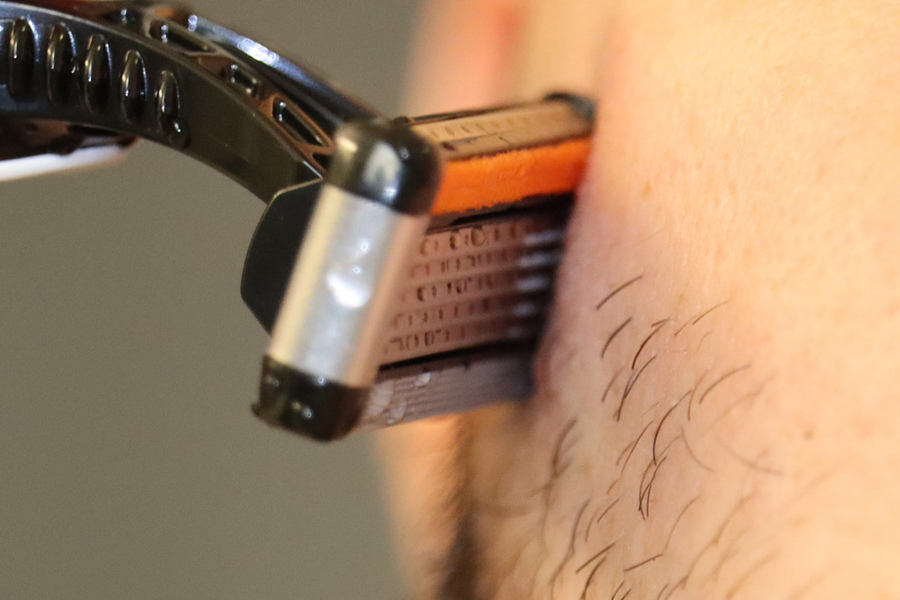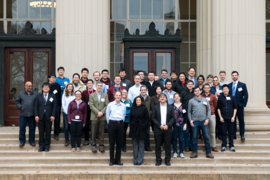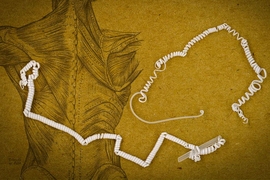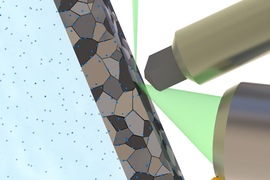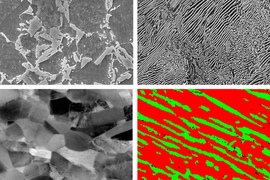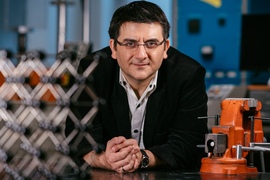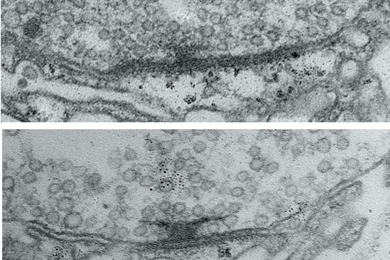Razors, scalpels, and knives are commonly made from stainless steel, honed to a razor-sharp edge and coated with even harder materials such as diamond-like carbon. However, knives require regular sharpening, while razors are routinely replaced after cutting materials far softer than the blades themselves.
Now engineers at MIT have studied the simple act of shaving up close, observing how a razor blade can be damaged as it cuts human hair — a material that is 50 times softer than the blade itself. They found that hair shaving deforms a blade in a way that is more complex than simply wearing down the edge over time. In fact, a single strand of hair can cause the edge of a blade to chip under specific conditions. Once an initial crack forms, the blade is vulnerable to further chipping. As more cracks accumulate around the initial chip, the razor’s edge can quickly dull.
The blade’s microscopic structure plays a key role, the team found. The blade is more prone to chipping if the microstructure of the steel is not uniform. The blade’s approaching angle to a strand of hair and the presence of defects in the steel’s microscopic structure also play a role in initiating cracks.
The team’s findings may also offer clues on how to preserve a blade’s sharpness. For instance, in slicing vegetables, a chef might consider cutting straight down, rather than at an angle. And in designing longer-lasting, more chip-resistant blades, manufacturers might consider making knives from more homogenous materials.
“Our main goal was to understand a problem that more or less everyone is aware of: why blades become useless when they interact with much softer material,” says C. Cem Tasan, the Thomas B. King Associate Professor of Metallurgy at MIT. “We found the main ingredients of failure, which enabled us to determine a new processing path to make blades that can last longer.”
Tasan and his colleagues have published their results today in the journal Science. His co-authors are Gianluca Roscioli, lead author and MIT graduate student, and Seyedeh Mohadeseh Taheri Mousavi, MIT postdoc.
A metallurgy mystery
Tasan’s group in MIT’s Department of Materials Science and Engineering explores the microstructure of metals in order to design new materials with exceptional damage-resistance.
“We are metallurgists and want to learn what governs the deformation of metals, so that we can make better metals,” Tasan says. “In this case, it was intriguing that, if you cut something very soft, like human hair, with something very hard, like steel, the hard material would fail.”
To identify the mechanisms by which razor blades fail when shaving human hair, Roscioli first carried out some preliminary experiments, using disposable razors to shave his own facial hair. After every shave, he took images of the razor’s edge with a scanning electron microscope (SEM) to track how the blade wore down over time.
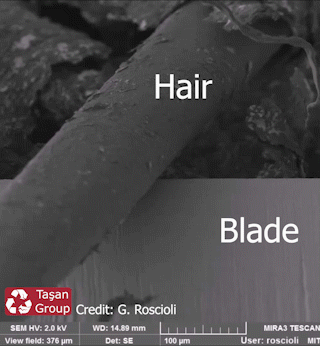
Surprisingly, the experiments revealed very little wear, or rounding out of the sharp edge over time. Instead, he noticed chips forming along certain regions of the razor’s edge.
“This created another mystery: We saw chipping, but didn’t see chipping everywhere, only in certain locations,” Tasan says. “And we wanted to understand, under what conditions does this chipping take place, and what are the ingredients of failure?”
A chip off the new blade
To answer this question, Roscioli built a small, micromechanical apparatus to carry out more controlled shaving experiments. The apparatus consists of a movable stage, with two clamps on either side, one to hold a razor blade and the other to anchor strands of hair. He used blades from commercial razors, which he set at various angles and cutting depths to mimic the act of shaving.
The apparatus is designed to fit inside a scanning electron microscope, where Roscioli was able to take high-resolution images of both the hair and the blade as he carried out multiple cutting experiments. He used his own hair, as well as hair sampled from several of his labmates, overall representing a wide range of hair diameters.
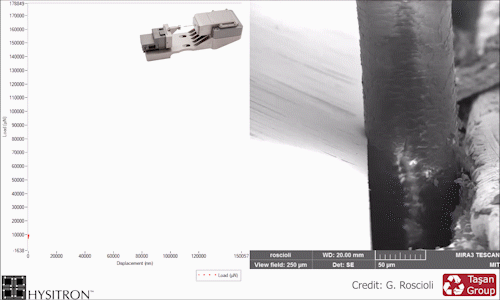
Regardless of a hair’s thickness, Roscioli observed the same mechanism by which hair damaged a blade. Just as in his initial shaving experiments, Roscioli found that hair caused the blade’s edge to chip, but only in certain spots.
When he analyzed the SEM images and movies taken during the cutting experiments, he found that chips did not occur when the hair was cut perpendicular to the blade. When the hair was free to bend, however, chips were more likely to occur. These chips most commonly formed in places where the blade edge met the sides of the hair strands.
To see what conditions were likely causing these chips to form, the team ran computational simulations in which they modeled a steel blade cutting through a single hair. As they simulated each hair shave, they altered certain conditions, such as the cutting angle, the direction of the force applied in cutting, and most importantly, the composition of the blade’s steel.
They found that the simulations predicted failure under three conditions: when the blade approached the hair at an angle, when the blade’s steel was heterogenous in composition, and when the edge of a hair strand met the blade at a weak point in its heterogenous structure.
Tasan says these conditions illustrate a mechanism known as stress intensification, in which the effect of a stress applied to a material is intensified if the material’s structure has microcracks. Once an initial microcrack forms, the material’s heterogeneous structure enabled these cracks to easily grow to chips.
“Our simulations explain how heterogeneity in a material can increase the stress on that material, so that a crack can grow, even though the stress is imposed by a soft material like hair,” Tasan says.
The researchers have filed a provisional patent on a process to manipulate steel into a more homogenous form, in order to make longer-lasting, more chip-resistant blades.
“The basic idea is to reduce this heterogeneity, while we keep the high hardness,” Roscioli says. “We’ve learned how to make better blades, and now we want to do it.”
